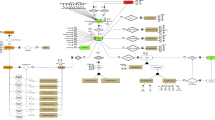Abstract
In this paper, we study a new problem of mining dynamic association rules with comments (DAR-C for short). A DAR-C contains not only rule itself, but also its comments that specify when to apply the rule. In order to formalize this problem, we first present the expression method of candidate effective time slots, and then propose several definitions concerning DAR-C. Subsequently, two algorithms, namely ITS2 and EFP-Growth2, are developed for handling the problem of mining DAR-C. In particular, ITS2 is an improved two-stage dynamic association rule mining algorithm, while EFP-Growth2 is based on the EFP-tree structure and is suitable for mining high-density mass data. Extensive experimental results demonstrate that the efficiency and scalability of our proposed two algorithms (i.e., ITS2 and EFP-Growth2) on DAR-C mining tasks, and their practicability on real retail dataset.
Similar content being viewed by others
References
Agrawal R, Imielinski T, Swami A (1993) Mining association rules between sets of items in large databases. In: Proceedings of the ACM SIGMOD conference on management of data, pp 207–216
Agrawal R, Srikant R (1994) Fast algorithms for mining association rules. In: Proceedings of the 20th international conference on very large data bases, pp 487–499
Cheung DW, Han J, Ng VT, Wong CY (1996) Maintenance of discovered association rules in large databases: an incremental updating technique. In: Proceedings of the 12th international conference on data engineering, pp 106–114
Cheng J, Ke Y, Ng W (2008) A survey on algorithms for mining frequent itemsets over data streams. Knowl Inf Syst 16(1): 1–27
Zhang S, Huang Z, Zhang J, Zhu X (2008) Mining follow-up correlation patterns from time-related database. Knowl Inf Syst 14(1): 81–100
Ke Y, Cheng J, Ng W (2008) An information-theoretic approach to quantitative association rule mining. Knowl Inf Syst 16(2): 213–244
Liu J, Rong G (2005) Mining dynamic association rules in databases. In: Proceedings of the international conference on computational intelligence and security, pp 688–695
Agrawal R, Srikant R (1995) Mining sequential patterns. In: Proceedings of the 11th international conference on data engineering, pp 3–14
Han J, Pei J, Mortazavi-Asl B, Chen Q, Dayal U, Hsu M (2000) FreeSpan: frequent pattern-projected sequential pattern mining. In: Proceedings of the sixth ACM SIGKDD international conference on knowledge discovery and data mining, pp 355–359
Garofalakis MN, Rastogi R, Shim K (1999) SPIRIT: sequential pattern mining with regular expression constraints. In: Proceedings of the 25th international conference on very large data bases, pp 223–234
Srikant R, Agrawal R (1996) Mining sequential patterns: generalizations and performance improvements. In: Proceedings of the 5th international conference on extending database technology, pp 3–17
Ozden B, Ramaswamy S, Silberschatz A (1998) Cyclic association rules. In: Proceedings of the 14th international conference on data engineering, pp 412–421
Qin M, Hwang K (2004) Frequent episode rules for Internet anomaly detection. In: Proceedings of the 3rd IEEE international symposium on network computing and applications, pp 161–168
Han J, Gong W, Yin Y (1998) Mining segment-wise periodic patterns in time-related databases. In: Proceedings of the 4th international conference on knowledge discovery and data mining, pp 214–218
Verma K, Vyas OP (2005) Efficient calendar based temporal association rule. SIGMOD Record 34(3): 63–70
Li Y, Ning P, Sean Wang X, Jajodia S (2003) Discovering calendar-based temporal association rules. Data Knowl Eng 44(2): 193–218
Lu H, Han J, Feng L (1998) Stock movement prediction and n-dimensional inter-transaction association rules. In: Proceedings of the 3rd ACM-SIGMOD workshop on research issues on data mining and knowledge discovery, vol~12, pp 1–7
Agrawal R, Psaila G (1995) Active data mining. In: Proceedings of the 1st international conference on knowledge discovery and data mining, pp 3–8
Ganti V, Gehrke J, Ramakrishnan R (1999) A framework for measuring changes in data characteristics. In: Proceedings of the 18th ACM SIGMOD-SIGACT-SIGART symposium on principles of database systems, pp 126–137
Liu B, Hsu W, Ma Y (2001) Discovering the set of fundamental rule changes. In: Proceedings of the 7th ACM SIGKDD international conference on knowledge discovery and data mining, pp 335–340
Dong G, Li J (2005) Mining border descriptions of emerging patterns from dataset pairs. Knowl Inf Syst 8(2): 178–202
Au W-H, Chan KCC (2002) Fuzzy data mining for discovering changes in association rules overtime. In: Proceedings of the 2002 IEEE international conference on fuzzy systems, vol 2, pp 890–895
Au W-H, Chan KCC (2005) Mining changes in association rules: a fuzzy approach. Fuzzy Sets Syst 149(1): 87–104
Liu B, Hsu W, Han H-S, Xia Y (2000) Mining changes for real-life applications. In: Proceedings of the 2nd international conference on data warehousing and knowledge discovery, pp 337–346
Shen B, Yao M (2007) Research on a new kind of dynamic association rule and its mining algorithms. http://www.paper.edu.cn/paper.php?serial_number=200712-3
Ramaswamy S, Mahajan S, Silberschatz A (1998) On the discovery of interesting patterns in association rules. In: Proceedings of the 24th international conference on very large data bases, pp 368–379
Lee W-J, Jiang J-Y, Lee S-J (2008) Mining fuzzy periodic association rules. Data Knowl Eng 65(3): 442–462
Burdick D, Calimlim M, Gehrke J (2001) MAFIA: a maximal frequent itemset algorithm for transactional databases. In: Proceedings of the 17th international conference on data engineering, pp 443–452
Han J, Pei J, Yin Y, Mao R (2004) Mining frequent patterns without candidate generation: a frequent-pattern tree approach. Data Min Knowl Discov 8(1): 53–87
IBM Almaden Research Center (2009) Quest synthetic data generation code. http://www.almaden.ibm.com/cs/projects/iis/hdb/Projects/data_mining/datasets/syndata.html
Deepa Sheenoy P, Srinivasa KG, Venugopal KR, Patnaik LM (2005) Dynamic association rule mining using genetic algorithms. Intell Data Anal 9(5): 439–453
Author information
Authors and Affiliations
Corresponding author
Rights and permissions
About this article
Cite this article
Shen, B., Yao, M., Wu, Z. et al. Mining dynamic association rules with comments. Knowl Inf Syst 23, 73–98 (2010). https://doi.org/10.1007/s10115-009-0207-1
Received:
Revised:
Accepted:
Published:
Issue Date:
DOI: https://doi.org/10.1007/s10115-009-0207-1




